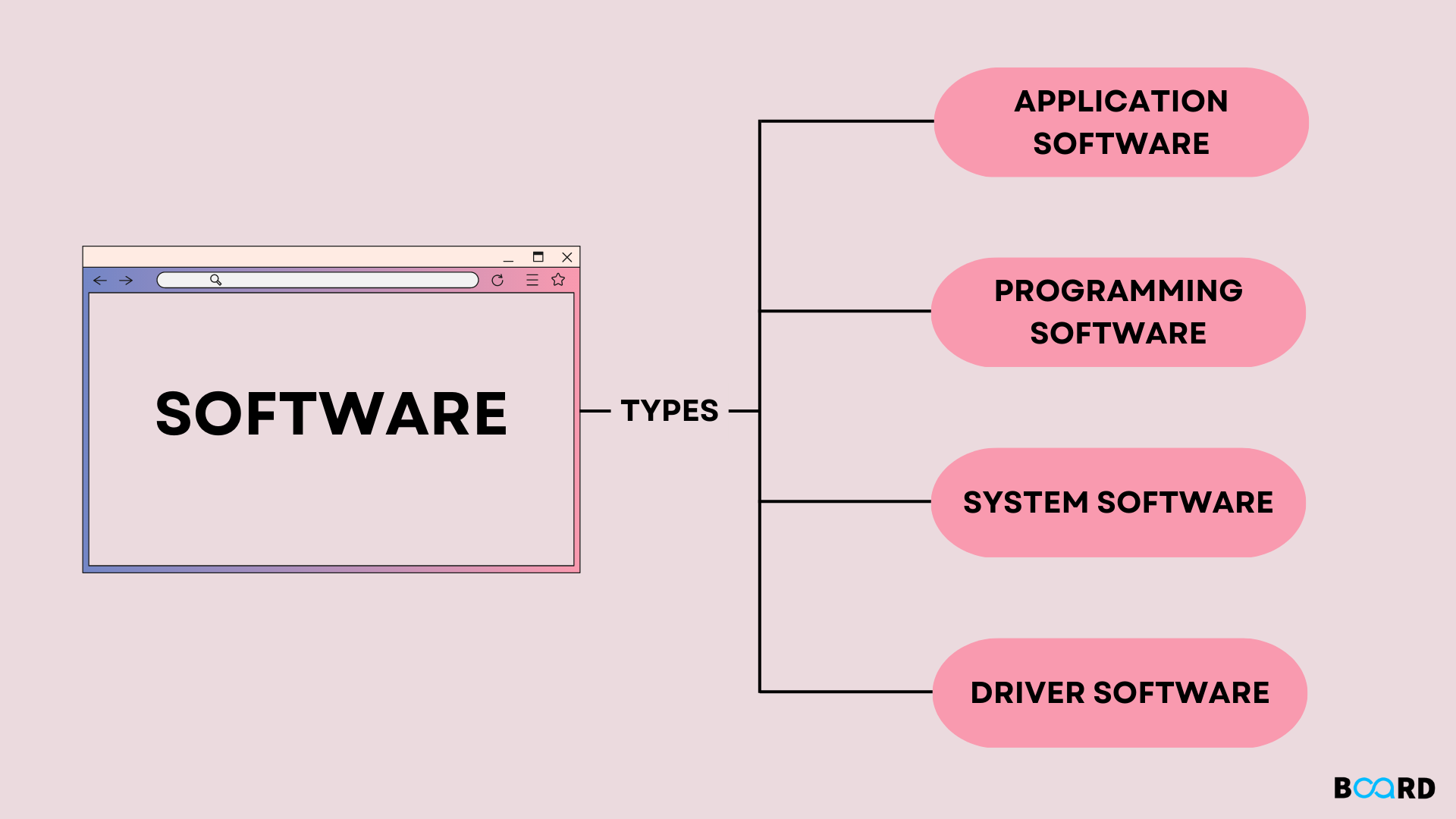So, you’re curious about the different types of software out there? Well, you’ve come to the right place! In this article, we’re going to explore the major types of software and break down what each one does. Whether you’re a tech enthusiast or just looking to expand your knowledge, this is the perfect article to get you up to speed on the fascinating world of software. From operating systems to applications, we’ll cover it all. So, let’s jump right in and discover the exciting varieties that make our digital world thrive! When it comes to software, there are various types that serve different purposes. Understanding the major types of software can help you navigate the digital world and make informed decisions about the tools you use. In this article, we will explore the definitions, examples, and importance of operating system software, application software, system software, programming software, driver software, utility software, database software, networking software, security software, and web development software.
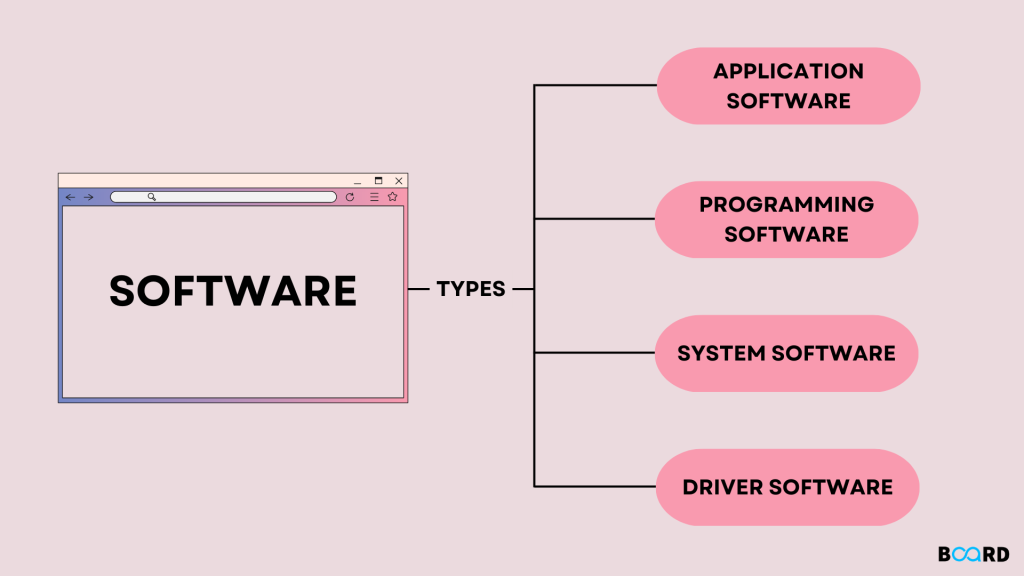
This image is property of www.boardinfinity.com.
Operating System Software
Definition
Operating system (OS) software is the foundation of any computer system. It manages all hardware and software resources, allowing them to work together efficiently. The OS provides a user-friendly interface, manages system resources like memory and processing power, and facilitates communication between software applications and hardware devices.
Examples
Some well-known examples of operating system software include Microsoft Windows, macOS, Linux, and Android. These systems enable users to interact with their devices and run various types of software smoothly.
Application Software
Definition
Application software, also known as apps or programs, is designed to perform specific tasks or functions for users. Unlike operating systems, application software is not essential for the functioning of a computer system. It is developed to serve specific purposes, such as word processing, multimedia editing, accounting, gaming, and more.
Types of Application Software
There are numerous types of application software available, catering to different needs and interests. Some common examples include:
-
Word processing software: Examples of popular word processing software are Microsoft Word, Google Docs, and OpenOffice Writer. These tools allow users to create, edit, and format text documents.
-
Photo editing software: Applications like Adobe Photoshop, GIMP, and Paint.NET provide users with advanced editing features to enhance and manipulate digital images.
-
Accounting software: QuickBooks, Xero, and FreshBooks are widely used accounting software that help businesses manage their financial records, invoicing, and tax preparation.
-
Gaming software: Gaming enthusiasts can indulge in various gaming software like Steam, Epic Games Store, and Origin to access and play a wide range of video games.
These are just a few examples in the vast landscape of application software. There are countless specialized apps for different industries, hobbies, and personal needs.
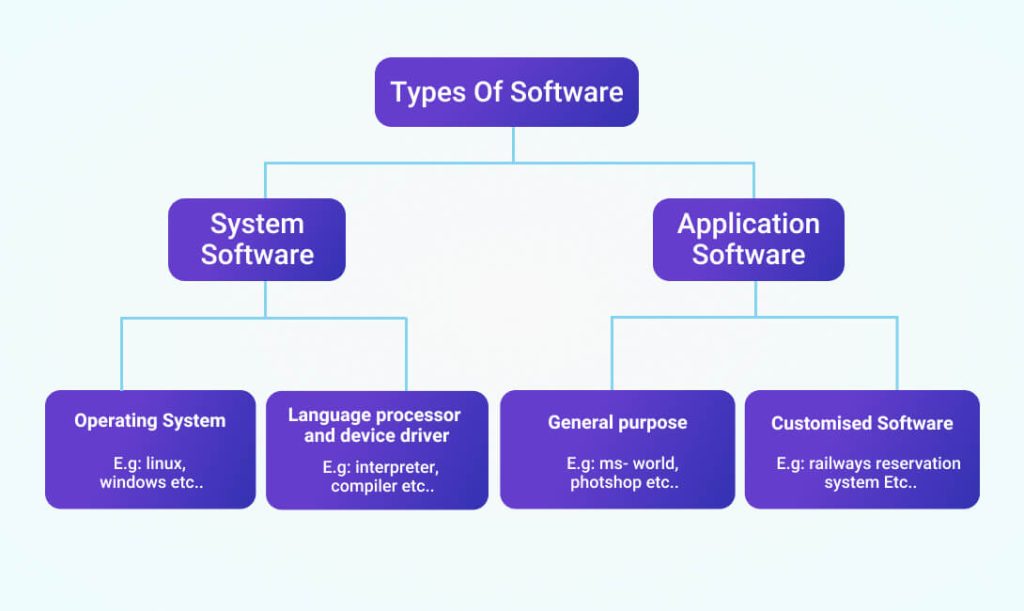
This image is property of www.openxcell.com.
System Software
Definition
System software is a type of software that assists in the management and operation of a computer system. It works closely with the operating system to optimize the performance of the hardware and facilitate communication between various software applications and the computer’s components.
Examples
Some examples of system software include:
-
Device drivers: These software programs enable communication between hardware devices, such as printers, scanners, and graphic cards, and the operating system. Examples include printer drivers, graphics card drivers, and USB drivers.
-
Firmware: Firmware is a type of software that is embedded in hardware devices. It provides low-level control and enables proper functioning of the device. Examples include the firmware in computer BIOS (Basic Input/Output System) and firmware in digital cameras.
-
Virtualization software: Virtualization software allows users to create virtual instances of operating systems within a single physical computer. Examples include VMware and VirtualBox.
System software plays a crucial role in ensuring the optimal function and performance of a computer system.
Programming Software
Definition
Programming software, also known as development tools, is designed for programmers and software developers. This type of software facilitates the creation, debugging, and management of computer programs and applications.
Examples
Some popular examples of programming software include:
-
Integrated Development Environments (IDEs): IDEs provide a complete set of tools for writing and testing code. Examples include Visual Studio, Eclipse, and Xcode.
-
Text Editors: Text editors, such as Sublime Text, Atom, and Notepad++, provide a basic platform for writing and editing code.
-
Compilers and Interpreters: These software tools convert human-written code into machine-readable code. Examples include GCC (GNU Compiler Collection) for C/C++ and Python Interpreter for Python programming language.
Programming software empowers developers to write, test, and debug code efficiently, allowing for the creation of robust and functional applications and programs.
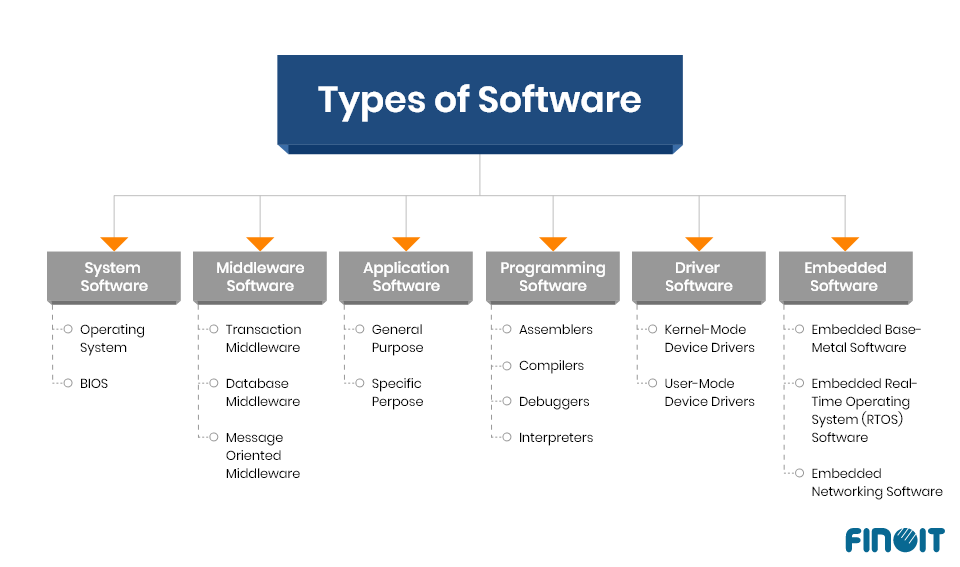
This image is property of www.finoit.com.
Driver Software
Definition
Driver software, also known as device drivers, enables the operating system to communicate and interact with hardware devices connected to a computer system. Without drivers, the OS would not recognize or be able to utilize the full capabilities of the hardware components.
Examples
Some common examples of driver software include:
-
Printer drivers: These drivers enable the computer to communicate with a printer, allowing users to print documents or images.
-
Graphics card drivers: These drivers optimize and ensure the proper functioning of graphics cards, enhancing the visual experience while gaming or performing graphical tasks.
-
Audio drivers: Audio drivers facilitate the playback and recording of sound on a computer system, ensuring high-quality audio output.
Driver software is essential for the smooth operation and compatibility of hardware devices with the operating system.
Utility Software
Definition
Utility software, as the name suggests, provides utility functions to enhance the performance and manage various aspects of a computer system. It focuses on tasks related to system maintenance, security, data recovery, and optimization.
Examples
Some examples of utility software include:
-
Antivirus software: Antivirus software, such as Norton, McAfee, and Avast, protects the computer system from viruses, malware, and other malicious threats.
-
Disk cleanup utilities: These utilities, such as CCleaner, help remove unnecessary files, temporary files, and other clutter from the system, freeing up disk space.
-
File compression tools: Tools like WinRAR and 7-Zip allow users to compress files and folders to save disk space and facilitate easier file transfer.
-
Data backup software: Applications like Acronis True Image and EaseUS Todo Backup help users create backups of their important files and folders, ensuring data protection.
Utility software provides essential functions to optimize and maintain a computer system, enhancing overall performance and security.
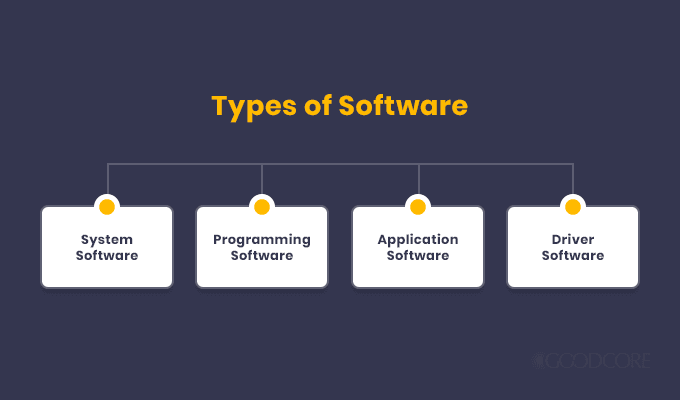
This image is property of cdn-galmn.nitrocdn.com.
Database Software
Definition
Database software is designed to manage, organize, and retrieve data efficiently. It provides a structured approach to storing and accessing data, allowing users to create, modify, and query databases.
Examples
Some widely used database software examples include:
-
MySQL: MySQL is an open-source relational database management system widely used for web applications and other projects requiring database functionality.
-
Oracle Database: Oracle Database is a robust and feature-rich relational database management system commonly used in enterprise-level applications.
-
Microsoft SQL Server: Microsoft SQL Server is a popular choice for database management, particularly for applications running on Windows servers.
-
MongoDB: MongoDB is a NoSQL database system that offers high flexibility and scalability for managing unstructured or semi-structured data.
Database software is essential for organizations and individuals who need to store and access large amounts of data efficiently.
Networking Software
Definition
Networking software facilitates communication and data exchange between multiple computers and devices within a network. It enables processes such as file sharing, remote access, and network administration.
Examples
Some examples of networking software include:
-
Network monitoring tools: Software like Nagios and SolarWinds provides comprehensive monitoring of network devices, identifying issues and optimizing network performance.
-
Remote desktop software: Applications like TeamViewer and AnyDesk enable users to access and control remote computers or devices over a network.
-
File transfer protocol (FTP) clients: FTP clients like FileZilla and WinSCP facilitate the transfer of files between computers over a network.
Networking software streamlines communication and collaboration within a network, making the exchange of data and resources efficient and secure.
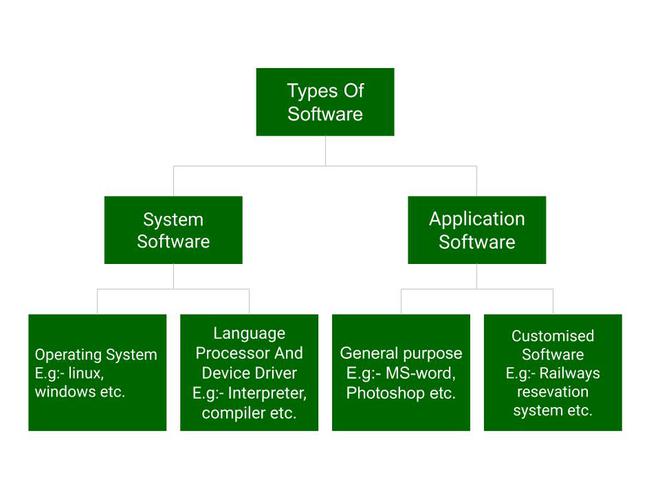
This image is property of media.geeksforgeeks.org.
Security Software
Definition
Security software protects computer systems and data from unauthorized access, malware, and other cyber threats. It includes tools for antivirus protection, network security, encryption, and internet security.
Examples
Some examples of security software include:
-
Antivirus software: Antivirus applications scan and remove viruses, malware, and other malicious programs from a computer system. Examples include AVG, Avira, and Kaspersky.
-
Firewall software: Firewall software monitors and controls network traffic, blocking unauthorized access and keeping the system protected from external threats. Examples include Norton Firewall, ZoneAlarm, and Windows Defender Firewall.
-
Virtual Private Network (VPN) software: VPNs create secure connections over public networks, allowing users to protect their online privacy and encrypt their internet activities. Examples include NordVPN, ExpressVPN, and CyberGhost.
Security software is crucial in safeguarding sensitive information and preventing unauthorized access or data breaches.
Web Development Software
Definition
Web development software encompasses tools and frameworks used to create, design, and maintain websites and web applications. From code editors to graphic design tools, these software packages help developers and designers create visually appealing and functional web content.
Examples
Some examples of web development software include:
-
Text editors and Integrated Development Environments (IDEs): Tools like Visual Studio Code, Sublime Text, and Atom provide developers with a platform to write and edit code for web applications.
-
Content Management Systems (CMS): CMS platforms like WordPress and Joomla provide a user-friendly interface for creating and managing website content without extensive coding knowledge.
-
Graphic design software: Graphics editors like Adobe Photoshop and Sketch help designers create visually stunning images, icons, and other visual elements for websites.
Web development software provides the necessary tools for developers and designers to create and maintain websites and web applications.
In conclusion, the major types of software outlined in this article serve specific functions and play key roles in different aspects of computer systems and digital environments. From the foundational operating system software to the specialized tools for application development, each type of software serves a specific purpose and contributes to the overall functionality and user experience of a computer system. By understanding and utilizing these major types of software, you can optimize your digital experience and unlock the full potential of your devices.
